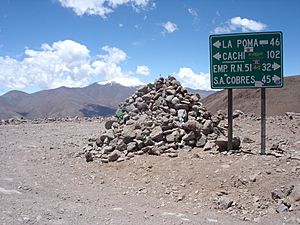Nevado de Acay facts for kids
Nevado de Acay is a very tall mountain in Argentina, standing about 5,950-metre-high (19,520 ft). It was formed from melted rock that pushed up from deep inside the Earth a long time ago. This type of rock is called monzonite. The mountain is connected to a system of cracks in the Earth's crust, called faults, which are also linked to nearby volcanoes.
Even though it doesn't have big, permanent ice sheets (glaciers) today, it gets a lot of snow in winter. This snow melts and feeds several streams and rivers, including the Rio Salado. Many old human sites and even mines have been found on Nevado de Acay.
Contents
About the Mountain
Nevado de Acay is located in the La Poma Department of Argentina's Salta Province. It is the highest peak in the Cuesta del Acay mountain range. The Calchaqui valley stretches out to the south from this mountain.
How Nevado de Acay Formed
The mountain is made of a rock called monzonite. This rock formed about 12.6 million years ago along a large crack in the Earth called the Calchaqui fault. It started as melted rock that pushed up but didn't break through the surface. Over millions of years, the rock above it wore away, exposing the monzonite. Some scientists think it might be even older, possibly around 18.9 to 26 million years old.
The monzonite rock contains different minerals like biotite, hornblende, and magnetite. Special mineral deposits, called skarn, also formed within the monzonite.
Connection to Other Volcanoes
Nevado de Acay is part of a volcanic system. It's close to the Negra Muerta volcanic complex and is linked to a large fault system called Calama-Olacapato-El Toro. Other volcanoes, like Aguas Calientes and Incahuasi Sur, are also connected to this same fault system.
Snow and Water
In the past, Nevado de Acay had glaciers, which left behind bowl-shaped valleys called cirques. Today, the permanent snowline is very high, around 5,800 metres (19,000 ft). However, snow covers the mountain during the winter, and even summer storms can bring snow.
Many important rivers start on Nevado de Acay. The Calchaqui River and the Rio Juramento both begin here and flow south. Other streams, like Arroyo Pircas and Arroyo Tastil, also start on the mountain. Most of these streams are fed by melting snow. The mountain acts like a natural wall, separating water that flows east into rivers from water that flows west into dry lake beds where it eventually evaporates.
Life on the Mountain
A type of iguanid lizard called Liolaemus multicolor has been found on Nevado de Acay. The valleys on the mountain, with their dry lake beds, were important places for ancient people. For example, the Las Cuevas V archeological site, which dates back to 600 BC - 400 AD, used these areas for resources.
Human History
Nevado de Acay was a special place for the Inka people. They built a sacred site on its summit, which was discovered in 2000. Later, two more sites were found on smaller peaks nearby. Some old records suggest the mountain was a key connection between the Inka province of Chicoana and the high plains known as the Puna. Today, National Route 40, a major road, passes close to the mountain.
People didn't just visit the very top of Nevado de Acay. Traces of mining and animal herding have been found lower down on its slopes. At least 53 old buildings have been identified at heights between 4,500–5,000 metres (14,800–16,400 ft). There are also historical mentions of a place called "San Bernardo de Acay" south of the mountain. Scientists are still learning about all the ancient structures on Nevado de Acay.
Mining History
Mining for gold and silver happened in the area during the time of Spanish rule. This mining stopped around 1656 because of a rebellion led by Pedro Bohórquez. The Spanish efforts to mine here might have even caused the rebellion. Later, an iron mine was active on the northern side of the mountain, but it is now abandoned. People have also found obsidian, a type of volcanic glass, in the area.
See also
 In Spanish: Nevado de Acay para niños
In Spanish: Nevado de Acay para niños



